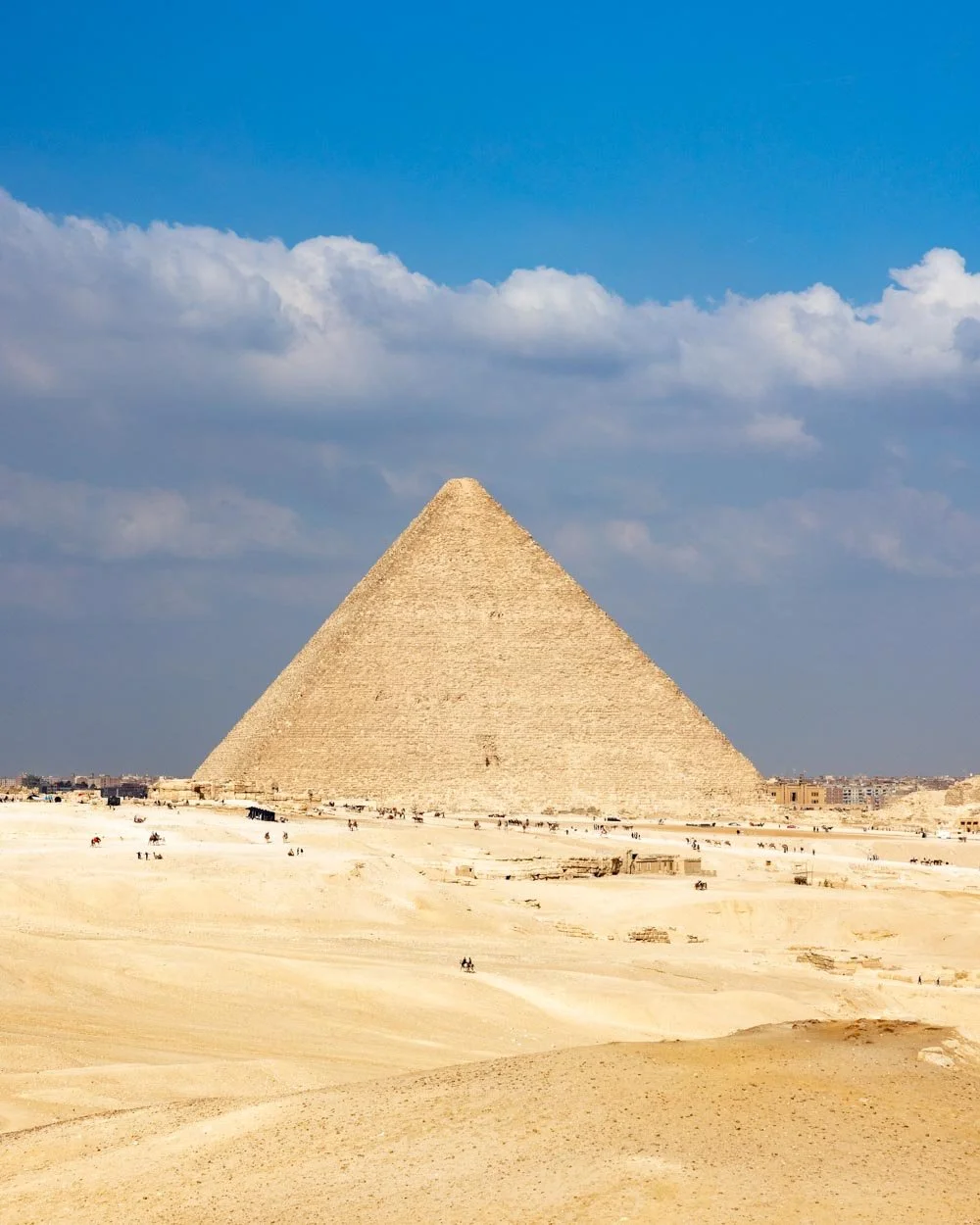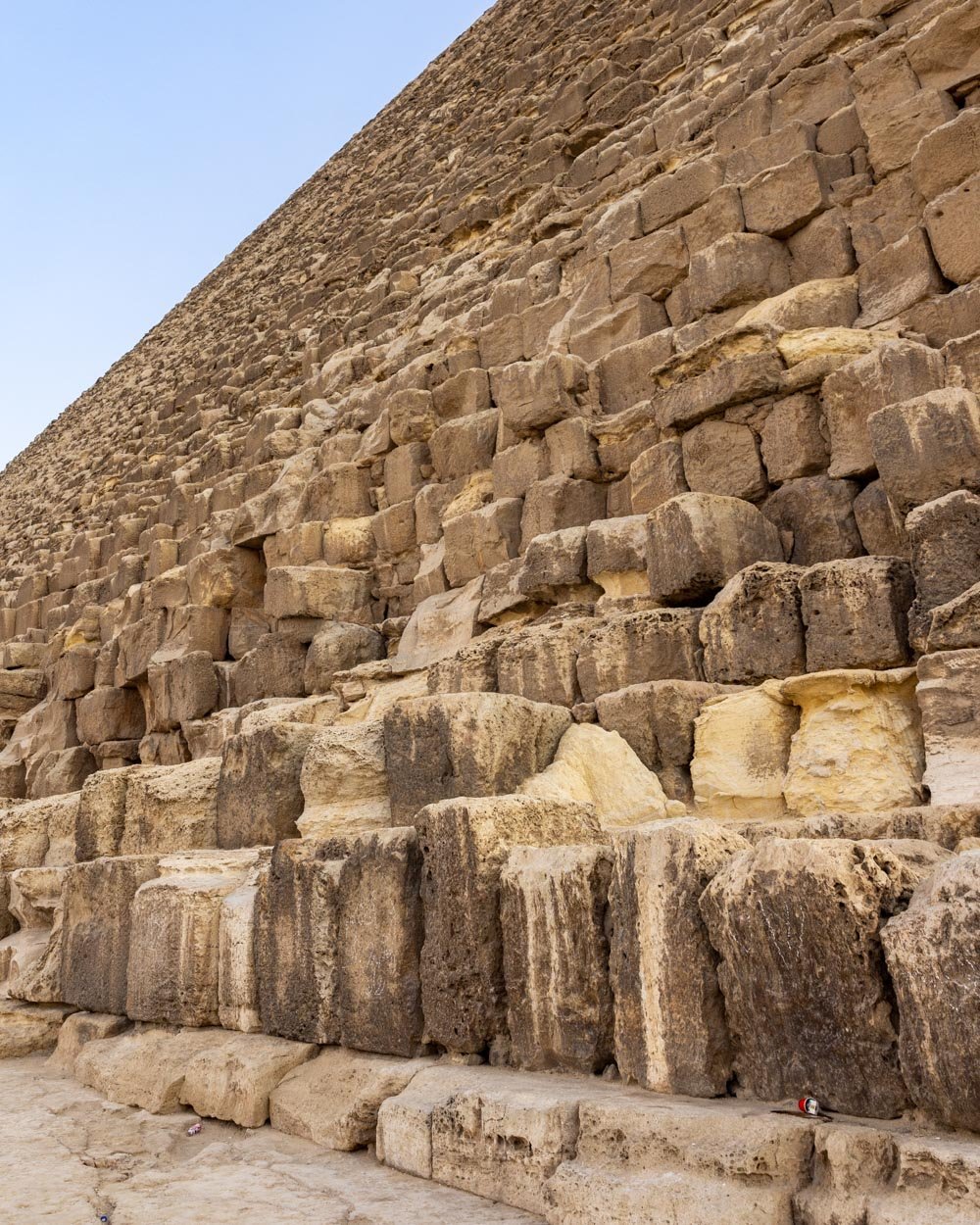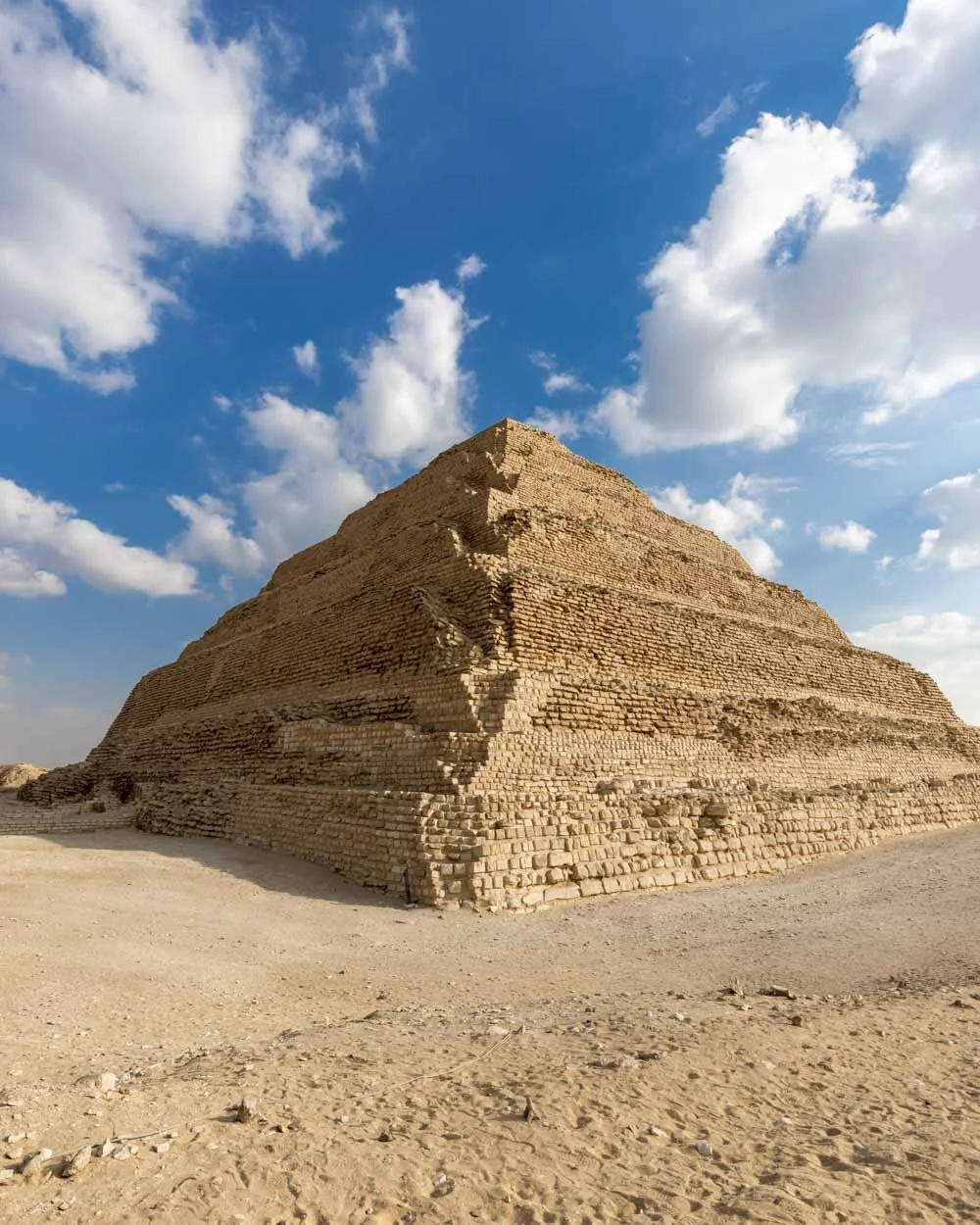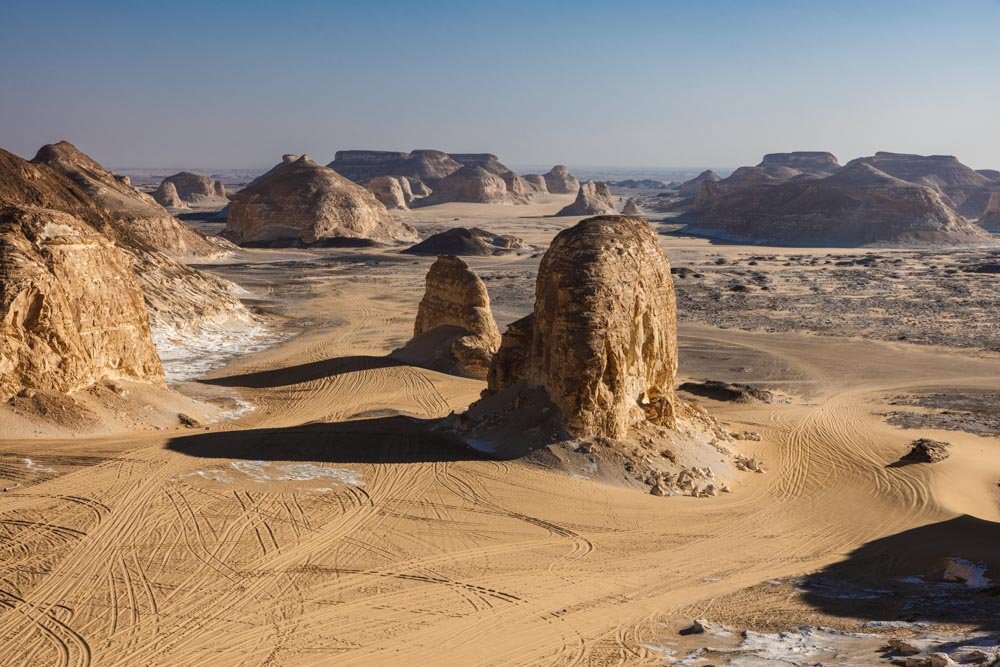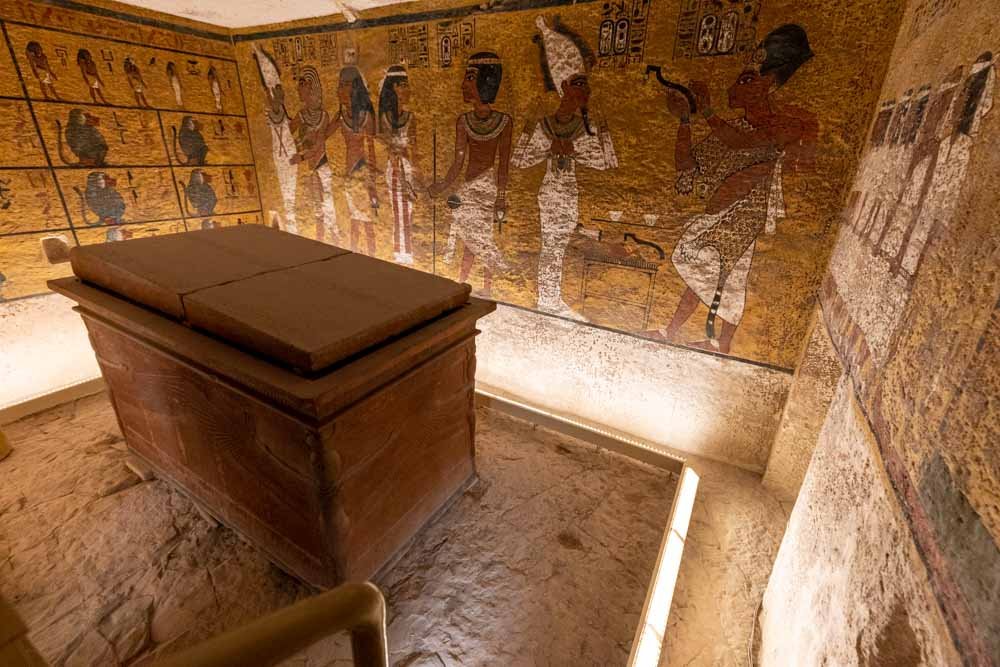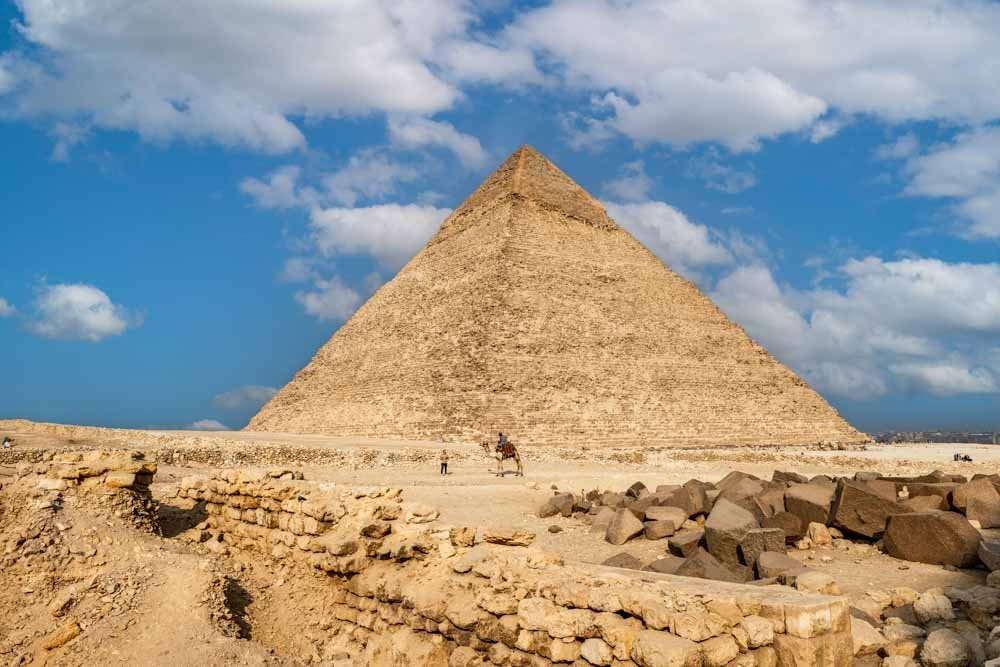The Pyramids of Giza are incredible feats of engineering which have stood the test of time - over 4500 years to be precise. These ancient structures inspire millions of people to visit Egypt every year, and whilst there is still a lot of mystery surrounding the pyramids, what we do know is pretty mind-boggling.
We’ve listed our favourite 28 facts about the Pyramids below, so that you can learn more about one of the ancient Egyptians most amazing achievements.
28 Mind Blowing Facts about the Pyramids
1. The Great Pyramid was built in 2,500 BC as a burial chamber
The Great Pyramid was built in the 4th dynasty of ancient Egypt and was intended to be the burial chamber for the pharaoh Khufu. Not much is known about Khufu, but he was the father of Khafre, who built the neighbouring pyramid, and grandfather of Menkaure, who built the third pyramid of Giza.
Burial was very important to the ancient Egyptians and pharaohs would begin preparing for their death as soon as their reign began. They believed that following certain burial procedures would guarantee passage to the afterlife.
2. The Great Pyramid was the tallest building in the world for 3,500 years
The Great Pyramid is a masterpiece of engineering, and was the tallest building in the world for over 3500 years! It was only superseded by the completion of Lincoln Cathedral in England in the 15th century. For perspective, the Great Pyramid is taller than Big Ben, the Statue of Liberty and the Leaning Tower of Pisa.
3. The Great Pyramid was originally 146m tall
This fact shows just how old the pyramids are, as the Great Pyramid was originally 146m tall, not 139m, as it is today. However, thousands of years of erosion and rocks crumbling has meant it has been reduced by 7m, and that’s despite Giza having very little rainfall.
4. The Great Pyramid is made up of over 2.3 million stones, each weighing 2.5 tons
It’s only when you visit the Pyramids that you realise how big each building block is. Each of the Great Pyramid’s stones are 1m x 1m x 2.5m, and they weigh over 2.5 tons! That’s the equivalent of a small SUV!
When you realise there’s 2.3 million of these stones, you begin to understand what an astonishing feat of engineering the pyramids truly are.
5. The stones of the Kings Chamber (inside the Great Pyramid) weigh up to 80 tons each and were hauled to a height of over 100m above ground
It is impressive enough to think about people hauling the main stones to form the Great Pyramid, but archaeologists really struggle to convincingly explain how the stones of the King’s Chamber in the Great Pyramid got there. Firstly, the granite blocks in the King’s Chamber weigh over 80 tons each (the equivalent of 30 SUVs) and there are hundreds of them.
Secondly, they were hauled to over 100m above ground level. With our current understanding of the technological capabilities of ancient Egypt, the belief is that this was done with either a very, very long ramp, or pulley system - which would have needed hundreds of people to haul.
6. The sarcophagus in the Great Pyramid was cut from a single stone and it was bigger than the passageways leading to the Kings Chamber
It would seem logical to build the pyramid and then bring a sarcophagus in through the passageways after its construction. However, Khufu’s sarcophagus was made from a single piece of granite that is bigger than the passageways leading into the King’s Chamber.
This means that the builders would have had to have dropped the incredibly big and heavy sarcophagus into the chamber mid-construction, and the rest of the pyramid would have been built around it.
7. You can go inside the pyramids
At time of writing, you can go inside two of the three Pyramids of Giza. The Great Pyramid of Giza (Khufu’s) is always open, the second pyramid that is open alternates each year. Going inside the pyramids is a real adventure and exploring the passages and burial chambers is fascinating, although it’s not for anyone who suffers from claustrophobia!
8. The location of the Pyramids of Giza was chosen due to its proximity to a quarry
You may wonder why the pyramids were built in the desert, but there was a sensible reason for this. The Giza Plateau was chosen due to its proximity to a quarry big enough to yield the 2.3 million stones needed to build the Great Pyramid. It was also close to the Nile when it flooded (something that doesn’t happen anymore following the construction of the Aswan Dam), which enabled other materials to be transported close to the site.
9. Some of the stone which form the pyramids were quarried in Aswan, 800km away
Whilst the majority of the materials for the pyramids were quarried nearby, some of the granite has been found to have been quarried from Aswan, nearly 800km away. It’s likely that the stones were transported down the Nile and then hauled to the pyramid site from the river.
10. Nowadays the pyramids are not in the middle of the desert
Most visitors to the pyramids are surprised to find that they are on the edge of the city and not in the middle of the desert. Whilst you can still get photos that make it look like they are in the middle of nowhere, you’ll see in the picture below that the city of Giza creeps right up to the plateau.
11. The pyramids originally had a bright white smooth stone casing
Erosion and looting has meant that the Pyramids of Giza look very different to how they would have done straight after their construction. Originally, all three pyramids were encased in a bright white limestone, which firsthand accounts said dazzled their eyes in the Egyptian sun. There was also gold casing on the very top stone.
However, the white casing has all but disappeared as it was taken to build other structures and monuments in Egypt. There is a small amount left at the top of Khafre’s Pyramid, but pollution and disrepair have dulled its original colour.
12. The pyramids were built by a workforce of over 20,000 men, and they weren’t slaves
Some historians believed that the pyramids were built by slaves, but archaeologists have proven that this is false as they found the tombs of the workers near the pyramids, a status that would not have been bestowed upon slaves. Historians have estimated that it would have required over 20,000 men to haul the number of heavy stones needed to complete a pyramid within the pharaoh’s lifetime.
13. The Pyramids of Giza are aligned within 1/10th of a degree of true north
Another fact that supports that the workers were not slaves is the skill needed to build such huge structures with such incredible precision. All of the Pyramids of Giza align with true north, to within a fraction of a degree. It’s believed that their knowledge of the stars enabled such a feat.
The workers precision made building a perfect pyramid possible, as even small errors can multiply on a pyramid that is 149m tall, and there are earlier attempts at building perfect pyramids in Egypt which failed because of this. You can see a couple of examples of this in Dahshur, just outside of Giza.
14. The ancient Egyptians didn’t have iron tools, or even wheels to help them build the pyramids
The fact that the Egyptians built the pyramids without iron tools, or wheels makes it even more remarkable. Instead of using wheels, the workers appeared to have used sleds and poured water on the sand to assist the moving of the huge blocks. The tools used to cut the granite would have been so soft that they would have needed to be replaced several times to cut a single stone.
15. Whilst it may look like Khafre’s Pyramid is taller, the Great Pyramid is the tallest of all the pyramids in Egypt
Any visitor to the Giza Plateau will be surprised when they’re told that the Great Pyramid is taller than Khafre’s, the middle pyramid of the three. However, Khafre’s pyramid is 10 metres shorter, but built on higher ground, giving the illusion that it is taller from many angles.
16. There are 9 pyramids built on the Giza Plateau
You will probably have seen the photos of the three huge pyramids in Giza, but there are also six small pyramids: three by Khufu’s pyramid and three by Menkaure’s pyramid. These are the pyramids of the wives or sisters of the pharaohs, but many are crumbling away and only vaguely resemble pyramids today.
17. The Great Pyramid has three chambers at varying heights
Construction of the tombs of the pharaohs began upon the start of their reign, and with the knowledge that some pharaohs died prematurely (Tutankhamun died at the age of 19). As ancient Egyptians had to be in their burial chambers within 70 days of their death, the builders of the pyramids needed a contingency plan in case the pharaoh died before the pyramid was built.
This is why it is believed that the Great Pyramid has three chambers of differing heights - to ensure that there were burial chambers ready at any time during construction.
18. Scientists have found a huge void above the Grand Gallery and don’t know what its purpose is
In 2016, scientists scanning the Great Pyramid found a void above the Grand Gallery that was previously not known about. No one knows what the purpose of it truly was, but some archaeologists have suggested it could be another section designed to help in the construction of the pyramid and the King’s Chamber.
19. Unlike the Valley of the Kings, the tombs of the pyramids do not have paintings and no mummies have ever been found inside them
Unlike many of the ancient Egyptians tombs, the tombs inside the pyramids are not decorated with paintings. This is unusual as most tombs in ancient Egypt have elaborate paintings on the walls and ceilings to help guide the soul of the deceased into the afterlife.
20. The Sphinx is one of the largest sculptures in the world
Many visitors to the pyramids are surprised at how large the Sphinx actually is, at over 70m long and 20m high, the Sphinx is one of the largest sculptures in the world. Sadly, you can’t walk up to the paws of the Sphinx like you used to be able to anymore.
21. The Sphinx wasn’t built above ground, but cut out of the ground below
Archaeologists have discovered that the Sphinx is a single rock that was quarried out of the bedrock of the Giza Plateau. Nowadays, bricks and other rock have been added to increase its stability.
22. A lot of the Sphinx was under sand until the 1920s, when it was excavated
After the Old Kingdom, the Sphinx and the Giza Plateau were abandoned. Drifting sand eventually buried the Sphinx up to its shoulders and it stayed this way until the late 19th century.
23. The Sphinx faces the sunrise during the autumn and spring equinoxes
Another nod to the importance of the sun rise in ancient Egypt is the fact that the Sphinx was built to perfectly align with the sunrise during the autumn and spring equinoxes - the exact midpoint of the year, between the longest and shortest days.
24. The Great Pyramid of Giza is the last remaining wonder of the ancient world
Of all the 7 wonders of the ancient world, the Great Pyramid is the only one that remains. The Colossus of Rhodes, Hanging Gardens of Babylon, Statue of Zeus at Olympia, Temple of Artemis at Ephesus, Mausoleum at Halicarnassus, and Lighthouse of Alexandria no longer exist - some were destroyed, some - such as the Hanging Gardens of Babylon - may never have existed, but the Great Pyramid is still here.
25. There are over 100 pyramids in Egypt
Whilst a lot of attention is paid to the Pyramids of Giza, Egypt has over 100 pyramids. They vary in condition, from some that are still in an excellent state, to those that have almost completely collapsed.
26. The first pyramid ever built was a step pyramid
The Pyramids of Giza were not the first pyramids to be built, but were the continuation of a trend started by the pharaoh Djoser. His pyramid was built about 100 years before the Pyramids of Giza and took the form of a step pyramid. It’s still there today and is believed to be the oldest building in the world.
27. The first perfect pyramid was built by Sneferu in Dahshur
The Pyramids of Giza weren’t the first “perfect” pyramids in Egypt either. Before the Red Pyramid in Dahshur was built, pyramids were uneven in their design. They were either stepped, or had different angles - the best example being the Bent Pyramid, also in Dahshur. However, the Red Pyramid is the first instance where the Egyptians cracked the method of building a pyramid with no changes in angle from the base to the top.
28. All pyramids are on the west bank of the Nile, as it’s where the sun sets
In keeping with their religious beliefs, all pyramids in Egypt were built on the west bank of the Nile, to face the sunset. The ancient Egyptians believed that the sun was a god who was reborn every morning in the east and died every evening in the west. The Egyptians hoped that when they died, their soul would follow the sun’s journey through the underworld and be reborn every day in an immortal lifecycle.
This post may contain affiliate links, meaning at no additional cost to you, that we will earn a small commission if you click through and decide to make a purchase. This helps towards the costs of running our website. Thanks for your support.


